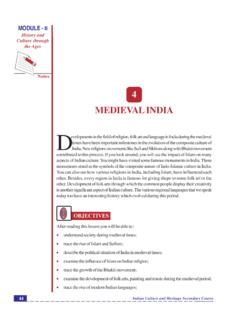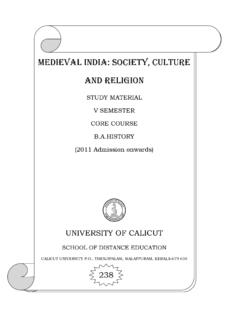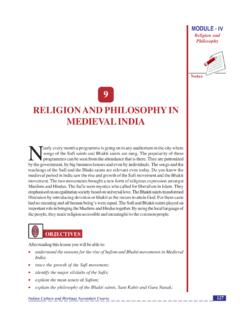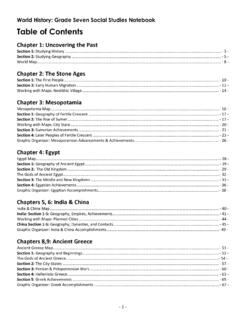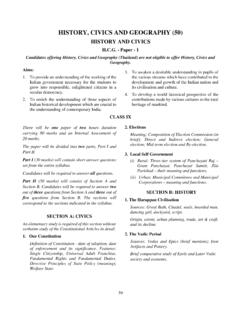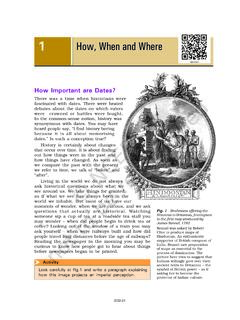Transcription of Ancient Education System of India - NCERT
1 I Did you know that India has been the centre of learning sinceancient times? How did we come to know about this? There are inscriptions on stones and copper, palm leaf recordsand our scriptures as evidences of the historic origins of learningin India . Today we follow an Education System in which learningtakes place through syllabus, curricula, textbooks and assessmentpractices. Have you ever thought what these were like in the past? In this feature story, we will give you glimpses of our ancienteducation must have heard or read that travellers from various regionshaving different climates and cultures began to visit parts of Indiafrom early times. To them, India was a land of wonder! The fame ofIndian culture , wealth, religions, philosophies, art, architecture, aswell as its educational practices had spread far and wide. Theeducation System of Ancient times was regarded as a source for theknowledge, traditions and practices that guided and Education System of India2022-23It so FEATURES OF Ancient Education SYSTEMFrom the time of Rigveda onwards, our Ancient Education systemevolved over the period and focused on the holistic development ofthe individual by taking care of both the inner and the outer System focused on the moral, physical, spiritual and intellectualaspects of life.
2 It emphasised on values such as humility,truthfulness, discipline, self-reliance and respect for all were taught to appreciate the balance between humanbeings and nature. Teaching and learning followed the tenets ofVedas and Upanishads fulfilling duties towards self, family andsociety, thus encompassing all aspects of life. Education systemfocused both on learning and physical development. In other words,the emphasis was on healthy mind and healthy body. You cansee that Education in India has a heritage of being pragmatic,achievable and complementary to OF EDUCATIONThe Ancient System ofeducation was theeducation of the Vedas,Brahmanas, Upanishadsand Dharmasutras. Youmust have heard thenames of Aryabhata,Panini, Katyayana andPatanjali. Their writingsand the medical treatises ofCharaka and Sushruta werealso some of the sources of learning. Distinction was also drawnA page from a manuscript* of the Rigveda*This birch bark manuscript of the Rigveda was found in Kashmir.
3 About 150 years ago, itwas used to prepare one of the earliest printed texts of the Rigveda, as well as an Englishtranslation. It is now preserved in a library in Pune, Maharashtra. (Class VI, Our Pasts-1, NCERT , 2017)heritage: something that is handed down from the past, as a tradition tenets: the mainprinciples of a religion or philosophy2022-23 Ancient Education System of India9191919191between Shastras (learneddisciplines) and Kavyas(imaginative and creativeliterature). Sources of learningwere drawn from variousdisciplines such as Itihas(history), Anviksiki (logic),Mimamsa (interpretation)Shilpashastra (architecture),Arthashastra (polity), Varta(agriculture, trade, commerce,animal husbandry) and Dhanurvidya (archery).Physical Education too was an important curricular area andpupils participated in krida (games, recreational activities),vyayamaprakara (exercises), dhanurvidya (archery) for acquiringmartial skills, and yogasadhana (training the mind and body)among others.
4 The Gurus and their pupils worked conscientiouslytogether to become proficient in all aspects of order to assess pupils' learning, shastrartha (learned debates)were organised. Pupils at an advanced stage of learning guidedyounger pupils. There also existed the System of peer learning, likeyou have group/peer Education System IN India A WAY OF LIFEIn Ancient India , both formal and informal ways of Education systemexisted. Indigenous Education was imparted at home, in temples,pathshalas, tols, chatuspadis and gurukuls. There were people inhomes, villages and temples who guided young children in imbibingpious ways of life. Temples were also the centres of learning andtook interest in the promotion of knowledge of our Ancient went to viharas and universities for higher was largely oral and students remembered and meditatedupon what was taught in the mapping of the variousdisciplines encompassed in the Vedasindigenous: originating or occurring naturally in a particular placeVihara: Buddhist monastery2022-23It so , also known as ashrams, were the residential places oflearning.
5 Many of these were named after the sages. Situated inforests, in serene and peaceful surroundings, hundreds of studentsused to learn together in gurukuls. Women too had access toeducation during the early Vedic period. Among the prominentwomen Vedic scholars, we find references to Maitreyi, Viswambhara,Apala, Gargi and Lopamudra, to name a that period, the gurus and their shishyas lived togetherhelping each other in day-to-day life. The main objective was tohave complete learning, leading a disciplined life and realising one'sinner potential. Students lived away from their homes for yearstogether till they achieved their goals. The gurukul was also theplace where the relationship of the guru and shishya strengthenedwith time. While pursuing their Education in different disciplineslike history, art of debate, law, medicine, etc., the emphasis was notonly on the outer dimensions of the discipline but also on enrichinginner dimensions of the Check1.
6 Why were travellers attracted towards India ?2. What were the sources of the Ancient Education System ?3. What were the features of Education System in Ancient India ?4. What was the role of guru in pupils lives?II In Part I, you have read about the Ancient Education System inashrams/gurukuls, and the way of life in them. This System continued to flourish during the time of the Buddhaand the subsequent monasteries/viharas were set up for monks and nuns tomeditate, debate and discuss with the learned for their quest forknowledge during this period. Around these viharas, othereducational centres of higher learning developed, which attractedmonastery: a place where monks line and worship2022-23 Ancient Education System of India9393939393students from China, Korea, Tibet, Burma, Ceylon, Java, Nepaland other distant AND UNIVERSITIESThe Jataka tales, accounts given by Xuan Zang and I-Qing (Chinesescholars), as well as other sources tell us that kings and societytook active interest in promoting Education .
7 As a result many famouseducational centres came into existence. Among the most notableuniversities that evolved during this period were situated atTakshashila, Nalanda, Valabhi, Vikramshila, Odantapuri andJagaddala. These universities developed in connection with theviharas. Those at Benaras, Navadeep and Kanchi developed inconnection with temples and became centres of community life inthe places where they were institutions catered to the needs of advanced level students joined the centres of higher learning and developedtheir knowledge by mutual discussions and debates with only this, there was also occasional summoning by a king toa gathering in which the scholars of the country of various viharasand universities would meet, debate and exchange their this section we will give you glimpses of two universities of theancient period. These universities were considered among the bestcentres of learning in the world. These have been recently declaredheritage sites by the United Nations Educational, Scientific andCultural Organization (UNESCO).
8 TAKSHASHILA OR TAXILAIn Ancient times, Takshashila was a noted centre of learning,including religious teachings of Buddhism, for several centuries. Itcontinued to attract students from around the world until itsdestruction in the 5th century CE. It was known for its highersummon: to officially arrange a meeting of peopleuniversity: institution of higher education2022-23It so and the curriculum comprised the study of ancientscriptures, law, medicine, astronomy, military science and theeighteen silpas or became famous as aplace of learning due to its teachers'expertise. Among its noted pupils werethe legendary Indian grammarian,Panini. He was an expert in languageand grammar and authored one of thegreatest works on grammar calledAshtadhyayi. Jivaka, one of the mostrenowned physicians in Ancient India ,and Chanakya (also known as Kautilya),a skilled exponent of statecraft, both studied here. Students cameto Takshashila from Kashi, Kosala, Magadha and also from othercountries in spite of the long and arduous journey they had was an Ancient Indiancity, which is now in north-westernPakistan.
9 It is an importantarchaeological site and theUNESCO declared it to be a WorldHeritage Site in 1980. Its famerested on the University, whereChanakya is said to havecomposed his Alexander Cunningham discovered its ruins inthe mid-19th OF THE TEACHERT eachers had complete autonomy in all aspects from selection ofstudents to designing their syllabi. When the teacher was satisfiedwith the performance of the students, the course stamp ofIndian grammarian, Paniniautonomy: freedom to act on one s will statecraft: the skill of governing a country2022-23 Ancient Education System of India9595959595He would admit as many students as he liked and taught what hisstudents were keen to learn. Debate and discussions were theprimary methods of teaching. Teachers were assisted by theiradvanced level UNIVERSITYN alanda, when Xuan Zang visited it,was called Nala and was a centre ofhigher learning in various University attracted scholars fromthe different parts of the country aswell as world.
10 The Chinese scholarsI-Qing and Xuan Zang visited Nalandain the 7th century CE. They have givenvivid accounts of Nalanda. They havenoted that as many as one hundreddiscourses happened on a daily basis, in a variety of disciplinesthrough the methods of debate and discussions. Xuan Zang himselfbecame a student of Nalanda to study yogashastra. He hasmentioned that the Chancellor of Nalanda, Shilabhadra, was thehighest living authority in yoga. The courses of study offered byNalanda University covered a wide range, almost the entire circle ofknowledge then available. Students at Nalanda studied the Vedasand were also trained in fine arts, medicine, mathematics,astronomy, politics and the art of Ancient Nalanda was a centre oflearning from the 5th century CE to12th century CE. Located in presentday Rajgir, Bihar, India , Nalanda wasone of the oldest universities of theworld and UNESCO declared theruins of Nalanda Mahavihara, a worldheritage site.











